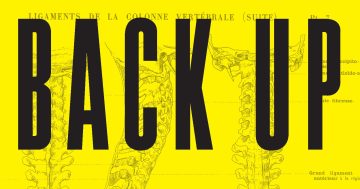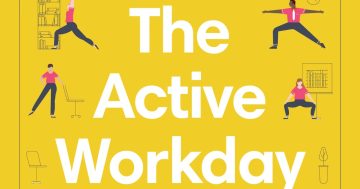Lindsay Tigar* says sitting in an office may not seem like a dangerous job, but there are five common injuries that can place stress on our bodies.

Photo: People Images
Even if you love your job, spending eight-plus hours a day, five days a week, in an office chair doesn’t do wonders for your body.
In fact, The Mayo Clinic has linked prolonged sitting to a number of health issues, from abnormal cholesterol levels to high blood pressure and a higher risk of cardiovascular disease.
Many professionals will also experience aches and pains, thanks to their gigs.
It’s not all bad news though.
Certain stretches and lifestyle habits can lower the stress on our bodies.
Here, experts recommend strategies to implement today:
Forward head posture condition
Ever wake up and your neck is so stiff, you can barely turn it?
Do you feel tension between your shoulder blades?
According to chiropractor Dr Joseph Taylor, there are plenty of reasons we experience this ache, but the main culprit is desk jobs.
Many people don’t sit up straight, which puts more pressure than we realise on the upper half of our bodies.
“Sitting at a computer often puts the shoulders in a rounded position and allows the head to lean forward,” Dr Taylor says.
“Being in this position for hours at a time, day after day, year after year can gradually cause the bones in the neck and upper back to change from their natural position to this abnormal forward position.”
It’s so common in professionals that it has its own medical condition: “Forward head posture”.
If left untreated, it can have some grave consequences, including headaches, migraines, muscle spasms, jaw or TMJ conditions, and decreased lung capacity.
“Oftentimes, the condition has been silently developing long before pain is experienced and, if not properly diagnosed, this condition will worsen over time and potentially reach a level that is irreversible,” Dr Taylor warns.
If you’re in pain, it’s important to see your GP for recommendations on physical therapy and treatment.
Dr Taylor also encourages professionals to demand proper ergonomics in the workplace, including computer screens that are placed at eye level.
“Sitting with your feet flat on the floor, back straight, and shoulders square will prevent excessive strain on the neck and upper back,” he says.
Chronic low back pain
It’s estimated 80 per cent of adults will experience chronic low back pain at some point in their life.
Movement specialist Samantha Parker says it is the leading cause of disability worldwide, and accounts for an estimated 26 million days of work lost annually.
Sure, shifting our chair position and desk height can alleviate symptoms, says Parker, but the true relief is found in our lower body, including our hip flexors, quadriceps, and hamstrings.
“The muscles in our legs attach to our pelvis, which is the gatekeeper between the upper body and the lower body,” she explains.
Because we sit at a 90-degree angle, the majority of our day, our muscles become tight, creating tension and pulling on our pelvis.
“Most of us will automatically do simple movements in our chair at our desk to move the torso to alleviate discomfort,” she says.
“Yet, we forget to stretch our legs.”
“And sticking them out straight for a few seconds is not going to cut it.”
Instead, create a habit of giving your hips and legs some TLC before bed.
This can be as simple as leg raises up and down, to the right and left, as well as lunges.
Carpal tunnel syndrome
We ask a lot of our wrists: typing, moving a mouse, lifting weights, groceries, and so on.
Overuse of this small part of our body can cause a very uncomfortable condition called Carpal Tunnel Syndrome (CTS).
Personal trainer and holistic health coach Koya Webb says more than eight million people are diagnosed each year, and you’re more at risk if you log hours in an office.
Webb defines CTS as wrist strain characterised by numbness, prickling, burning, or weakness in our hand.
It’s caused by excessive and repeated pressure on our median nerve.
If you worry you already have CTS, Webb says to see a doctor ASAP for solutions, and to get started with exercises to improve the health of your hands.
Slip or fall injuries
Most desk-bound professionals don’t consider their working conditions to be hazardous.
Especially compared with those who work in factories or outdoors, walking into a building every day doesn’t seem to hold much risk.
But according to chiropractor and personal trainer Dr Anthony Crifase, office workers are two to 2.5 times more likely to suffer from a disabling injury from a fall than non-office workers.
When you trip or lose your balance, most people have instant reactions, like landing on an outstretched hand.
Dr Crifase says this can cause damage to your shoulder, wrist, and upper body.
In an office setting, there are plenty of potential hurdles that can cause this injury, including loose carpeting, uneven tiles, wet floors, bad lighting, an open desk or drawer, and electrical cords.
If you see an issue that requires management to call maintenance, speak up.
It’s within your rights as an employee to have a safe working environment, and cleanliness is part of that.
Eye strain
Webb says up to 60 per cent of adults report experiencing digital eye strain, with symptoms ranging from soreness and heavy eyelids, to burning and itching eyes, as well as blurred vision and headaches.
Webb recommends “eye yoga”: a relaxed set of exercises that can be done throughout the day to improve the flexibility of your sight and improve your focus.
She suggests closing your eyes repeatedly, and then looking up, down, left and right.
“As you’re doing so, pretend you’re looking at the numbers on a clock in front of you.”
“Repeat looking from 12 to 3 and then from 6 to 9, then reverse the direction,” she says.
“You can also try blinking rapidly several times, and then closing your eyes for 20 seconds.”
* Lindsay Tigar is a freelance travel and lifestyle journalist. She tweets at @LindsayTigar. Her website is lindsaytigar.com.
This article first appeared at www.fastcompany.com.












